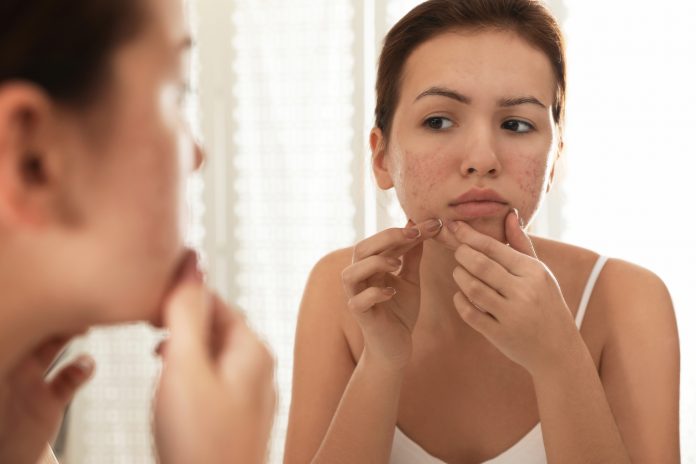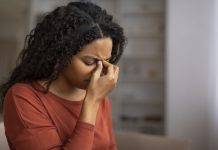Skin conditions often get worse when we are stressed – for example, during the COVID-19 pandemic. Have you just been diagnosed with acne rosacea? Are there any tips or tricks on how to manage it? Here, Dr Deborah Lee, Dr Fox Online Pharmacy, explains everything you need to know
Acne rosacea is a chronic, inflammatory skin condition which occurs on the face. It’s very common, affecting around 1 in 10 of the population. Although it is a type of acne, this is a different medical condition for example to acne vulgaris – the most common type which causes teenage spots.
Those who are living with rosacea will know it causes a great degree of distress and embarrassment. It causes redness and flushing of the central facial area – all too obvious as it’s right in the centre of the face. Many sufferers have low self-esteem and self-confidence. 77% say they have been suffered emotionally, 63% say it has affected their work, and 53% it has affected their relationships.
Rosacea is characterised by the following symptoms – facial flushing, redness, pimples, pustules, small dilated blood vessels called telangiectasia, and micro-oedema (facial swelling). It tends to affect the convex areas of the face such as the cheeks, the chin, the nose and the forehead. People with rosacea often have sensitive skin which feels like it’s stinging or bursting.
Acne rosacea causes
It’s important to think about the possible underlying causes of rosacea. Often, these provide the basis for treatment.
- Familial – The exact cause of rosacea is unknown, but it may be familial. For example, in one cross-sectional study, 50% of sufferers had an affected family member.
- Genes – Recently, HLA (human leukocyte antigen) genes have been linked to the development of rosacea. These specific genes are also linked to other autoimmune diseases, including, for example, type 1 diabetes mellitus, and coeliac disease.
- Demodex mites -The convex areas of the face have a rich supply of sebaceous glands and a dense nerve and blood supply. Demodex mites, found on the skin, inhabit these glands.
We all have these microscopic mites living in our hair follicles – in a 2014 US study Demodex DNA was found on the skin of 100% of people tested aged over 18. However, treating these mites in people with acne rosacea has been shown to reduce symptoms.
- Bacteria – The colonisation of the skin with other bacteria may also play a role – such as Bacillus oleronius, Staphylococcus epidermidis, Helicobacter pylori, and Bartonella Quintana.
- Cathelicidin – Levels of a protein called cathelicidin (LL-37) are abnormally elevated in the skin of people with rosacea. Cathelicidin is a protein which is important in the antimicrobial defence of the skin. It signals the inflammatory response in the skin and causes vascular changes and new blood vessel formation. Cathelicidin derives from a precursor called kallikrein-5 (KLK5).
- Rosacea triggers – Rosacea is a lifelong condition which flares up intermittently. Flare-ups seem to be caused by a number of triggers such as – change in temperature, being too hot, or being too cold, exercise, U/V light, spicy foods and alcohol. These directly stimulate certain skin receptors and cause the skin to flush bright red.
Stress also triggers rosacea, although the exact mechanism has not been confirmed. Stress activates the sympathetic nervous system. Rosacea sufferers may also have some underlying dysregulation of the parasympathetic nervous system.
Managing rosacea
Rosacea is something you were born with. Having rosacea has nothing to do with being unclean. It is a long term condition which will flare up from time to time. If you can understand what’s happening to your skin, and in particular, which triggers are causing flare-ups, you will learn how best to manage your own condition.
Everyone with rosacea is affected slightly differently. The condition may be mild, moderate or severe. In addition, some people will suffer more from redness and flushing, whereas others will have more papules, pustules or telangiectasia (broken blood vessels). Some people have sensitive and dry skin. This means everyone will find some treatments more effective than others. The treatments will not cure the condition – they can only help improve symptoms.
Consider the following steps
- Get an expert opinion – The diagnosis of rosacea should be confirmed by a medical specialist (dermatologist). Diagnosing rosacea diagnosis may not be straightforward. There are other conditions with similar symptoms, for example, acne vulgaris, seborrheic dermatitis, perioral dermatitis, carcinoid syndrome or systemic lupus erythematosus (SLE).
- Stress management – A survey from the National Rosacea Society reported:
- 91% of rosacea sufferers felt emotional stress had caused their rosacea to flare up.
- 45% felt stress caused frequent flare-ups
- 42% felt stress caused occasional flare-ups
Effectively managing stress can result in significant skin improvements. The NRS suggests tips for managing life’s daily stress.
- Healthy diet – In another survey, the National Rosacea Society reported that 78% of patients had altered their diet to try to improve their rosacea and that as a result, 95% felt they had seen an improvement in their symptoms.
Common triggers were hot coffee and hot tea, as well as peppers and spicy foods, tomatoes, citrus foods, cinnamon and chocolate.
Indeed, what you eat does seem to be linked to the health of your skin. A 2017 publication in the British Journal of Dermatology compared around 50,000 rosacea sufferers with over 4 million controls. The authors found there were significantly more gastrointestinal diseases in people with rosacea than in the control group. These diseases included coeliac disease, Crohn’s disease, ulcerative colitis, H.pylori infection, small intestinal bacterial overgrowth (SIBO) and irritable bowel syndrome.
It’s not clear exactly why this should be, however, the authors also recommended that rosacea patients, who develop GI symptoms, warrant special investigation and should be referred accordingly.
SIBO is known to be 13 times more common in rosacea patients than in those without skin disease. SIBO seems to alter intestinal transport time. In one study, treating SIBO with antibiotics led to complete resolution of rosacea, and these improvements were still seen at 3-year follow up.
Consider your dietary intake of prebiotics and probiotics
What are prebiotics ?
There is current interest in the possible role of the gut microbiome on rosacea. Prebiotics are fibre-rich foods which are not digested but stimulate health gut bacteria. Adding more fibre to your diet is important to be sure your microbiome has enough diversity.
What are probiotics?
These are live micro-organisms, which are ingested as dietary supplements, and confer overall health benefits. They include foodstuffs such as yoghurts, kefir, fermented cheeses (Cheddar, Gouda, and Parmesan, for example), and fermented vegetables such as sauerkraut and pickles. They contain large quantities of a variety of bacteria, for example, Bifidobacteria or Lactobacillus species. There are no studies so far, about the effect of probiotics on rosacea.
- Avoid rosacea triggers – This is an especially important part of rosacea management. If you can determine what causes your rosacea to flare-up – you can avoid this and then stop the flare-up’s happening.
Common things which cause flare-ups include a change in temperature, being too hot or too cold, hot drinks, alcohol, spicy foods, peppers, stress and anxiety, and exposure to sunlight (U/V A, and U/V B).
Some skin products can trigger rosacea, The American Academy of Dermatology recommends avoiding products which contain alcohol, fragrances, glycolic acid, lactic acid, menthol, sodium laurel sulphate and urea. Some types of makeup may also do this.
It may be difficult to assess what is causing your skin to flare up. The National Rosacea Society has an online booklet which you can fill in every day, over a 2-week period to help provide a picture.
- Always wear sunscreen – Protect your skin from U/V light every day – this is from both U/V-A and U/V-B.
Exposure to sunlight is a trigger for 80% of rosacea sufferers. Using daily sunscreen reduces the production of cathelicidin and reduces skin inflammation.
The British Association of Dermatologists (BAD) recommends the use of sunscreen containing at least an SPF-30 anti-UVB rating – and also a minimum of 4 out of 5 stars – for anti-UVA protection.
- Daily skincare regime – Use a gentle skin cleanser. Patients are often sensitive to the common ingredients in skincare products so these should be avoided e.g. alcohol, menthol, peppermint, eucalyptus, and clove oils.
Moisturising is especially important as many patients with rosacea have dry skin, which makes symptoms worse. Moisturisers repair the skin barrier function and help the skin retain water. They have been shown to support other skin treatments used to treat rosacea.
- Use topical treatments – There are a variety of skin creams and treatments which can be recommended initially by your GP, or by a specialist dermatologist
- Contraception – There is almost nothing in the medical literature about contraceptive recommendations for women with acne rosacea – remembering this is different from acne vulgaris.
However, one 2013 study using the UK General Practice database, compared 53,927 women with acne rosacea with the same number of controls. The investigators found a significant reduction in numbers of cases of acne rosacea in the population of women who had used the drug spironolactone. Spironolactone is a diuretic, but it also has anti-androgenic properties (anti-testosterone) and is frequently used in women to treat hirsutism.
There are no contraceptive pills containing spironolactone itself, but the combined pill Yasmin contains the progesterone drospirenone, and is often recommended to treat acne vulgaris.
There is not enough evidence to make any firm recommendations to choose Yasmin for women with acne rosacea, but this remains an interesting finding. All women who wish to take the combined pill, need a careful consultation first with their healthcare provider.
- Menopause – Acne rosacea may flare at menopause. The most common menopausal symptoms are hot flushes. Having a hot flush can trigger, acne rosacea, skin flare-ups.
You need to discuss with your doctor about how best to manage the situation. No-one knows what causes hot flushes, however, the frequent and precipitous, rise and fall of hormone levels which take place as you go through the menopausal transition, may be the trigger for the hot flush.
When you take hormone replacement therapy (HRT) this stabilises your hormone levels. It may be an idea to choose a longer-acting HRT preparation, such as a weekly skin patch, rather than daily administration of a tablet.
A quick guide to medical treatments for rosacea
For mild or moderate papules and pustules – topical 0.75% metronidazole gel applied thinly twice a day. 15% azelaic acid applied twice a day, is an alternative for people who do not have sensitive skin. (NICE 2018).
For moderate or severe papules and pustules – first-line antibiotics are oxytetracycline or tetracycline 500 mg twice daily 6-12 weeks, or doxycycline 100 mg once daily (unlicensed) as an alternative. Another option is lymecycline. Erythromycin is often used for pregnant women who cannot take tetracyclines.
If redness is a major problem, NICE also recommends brimonidine 0.5% gel. Brimonidine is an alpha-agonist which causes vasoconstriction and can prevent flushing for up to 12 hours after local application.
Other antibiotics taken by mouth are sometimes used, such as metronidazole, clarithromycin or azithromycin – although these are unlicensed for this purpose.
If treatment is successful, this can be continued long term, although treatment holidays are suggested after 6 months. Some people may need both systemic and topical treatment.
If symptoms are persistent and these measures are not helping, referral to a consultant dermatologist is suggested. Other oral treatments may be tried such as clonidine, or isotretinoin.
One additional option is the use of ivermectin 1% cream, or ivermectin tablets, which is effective against Demodex mites.
Sometimes laser treatment can be helpful.
Rosacea skincare
Rosacea is a life-long condition. Choosing a skincare regime may seem confusing when there are so many products to choose between. You will need to try different products to work out which ones seem to work best for your skin. Be patient, as you won’t see instant results.
It’s imperative to establish a good skincare regime as part of managing the condition.
- Choose simple, natural products. The best products for your skin are not necessarily the most expensive.
- Wash your face twice a day with an oil-free product. Be gentle with your skin. Pat it dry – don’t rub.
- Apply a moisturiser every morning which contains an SPF-30 anti-U/V-B sunscreen. The British Association of Dermatology (BAD) also recommend a sunscreen which has at least 4 out 5 stars for anti-U/V-A.
- Use a night-time moisturiser.
- Avoid products which have harsh ingredients – many people suffering from rosacea have sensitive skin. For example –
- Avoid products containing certain types of alcohol – specifically – ethanol, isopropyl alcohol and alcohol These can be dehydrating and cause skin irritation. ‘Good’ alcohols, however, are ‘fatty alcohols,’ such as cetyl alcohol, cetearyl alcohol, and stearyl alcohol, which have skin benefits. These are often used as thickening agents for skin products, are non-irritant, and often act as humectants, to help retain moisture.
- Avoid agents such as glycolic acid, salicylic acid and benzoyl peroxide which can cause irritation for sensitive skin.
- Topical retinoids have been reported to cause flare-ups in people with rosacea and should be avoided.
It’s hard to recommend a specific brand of products as there are so many on the market and everyone will have a different response to treatment. Cerave, Cetaphil, Aveeno, or Vanicream products, for example, are all recommended, but there are many excellent products.
Camouflage therapy
Many people suffering from a variety of skin conditions derive benefit from using ‘camouflage therapy‘. This involves using special foundation which is low in allergic potential and can be safely used in people for example, with acne rosacea.
For more information
- National Rosacea Society – All about rosacea
- Guidelines in Practice – Rosacea – newer treatments can avoid antibiotics
- American Academy of Dermatology Association – 6 Rosacea Skin Care Tips Dermatologists Give their Patients
- Rosacea – British Association of Dermatology











